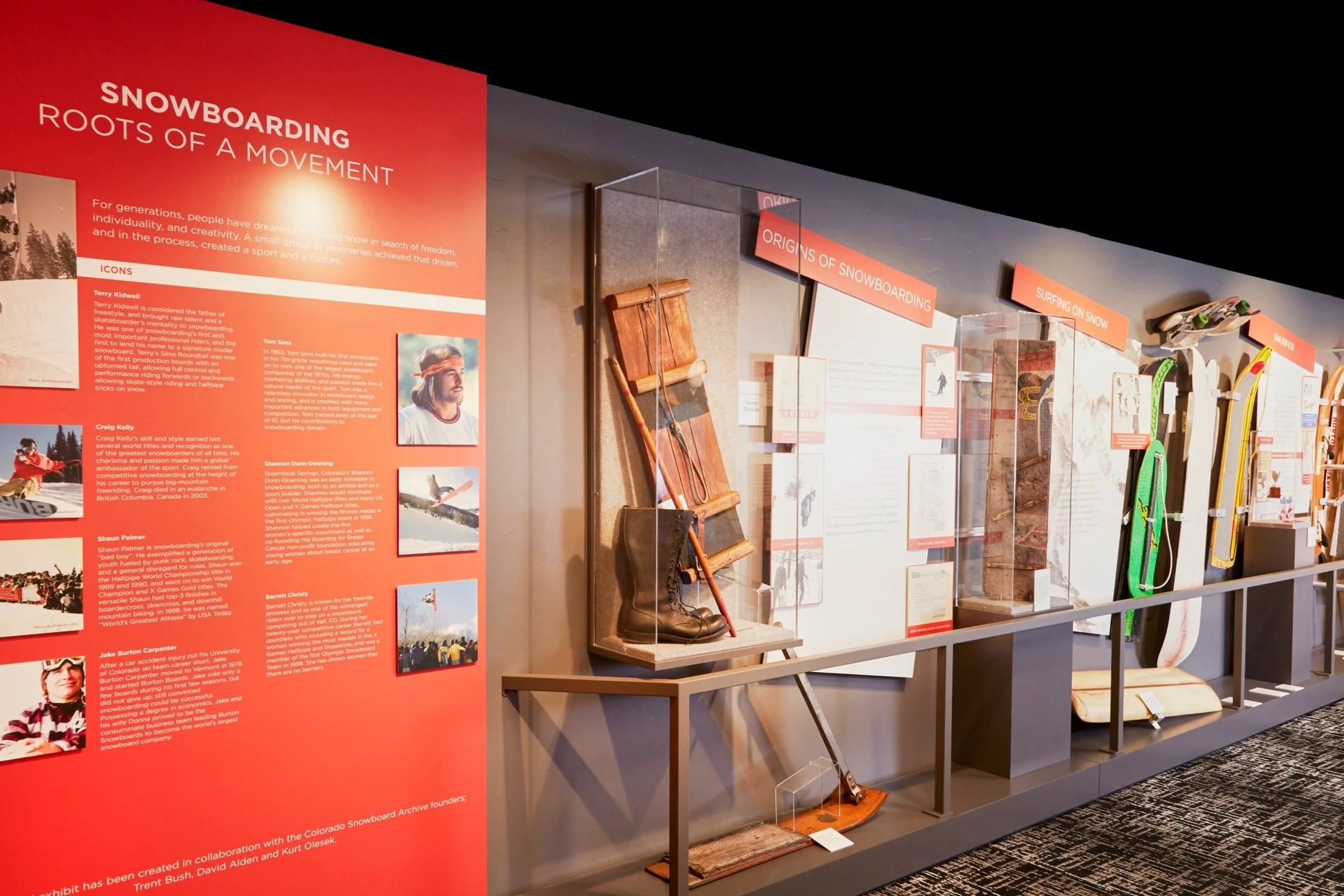Artifact Highlights - Poppen Family Collection
What does the Lemelson Center for the Study of Invention and Innovation at the Smithsonian Institution and the Colorado Snowsports Museum & Hall of Fame have in common? Both cultural institutions house a permanent collection of artifacts from Sherman Poppen, the inventor of the first commercially viable snowboard in the United States: the Snurfer. One of the original boards resides on display at the Smithsonian and five, which were originally on loan to the Colorado Snowsports Museum, are now part of their permanent collection thanks to the generosity of Sherman’s wife, Louise Poppen, and his daughter, Wendy Poppen.
The Colorado Snowsports Museum’s Snurfer display - now on view.
“We are honored Louise, Wendy, and the Poppen family entrusted the Museum to permanently house these artifacts. They are tangible connections to the past and help tell the story of the birth and rise of snowboarding in North America.”
On Christmas morning 1965, at home in Muskegon, Michigan, Sherman’s pregnant wife Nancy begged him to go outside and entertain their rambunctious daughters, Wendy, 10, and Laurie, 5. “You can imagine — it’s Christmas, and my wife is pretty uptight, and she said, ‘Sherman, you’ve got to take these kids out of the house,’ ” he recalled in 2009 in an interview with Steamboat Pilot & Today, a newspaper in Steamboat Springs, Colorado. “And we were having a huge snowstorm on the shores of Lake Michigan.”
That morning, Sherman first took out a sled, but its blades cut through the snow and got stuck in the sand beneath. Then he spotted Wendy’s child-size skis. Envisioning the dunes as surf able waves, he created a surf-able board by bracing the skis with wooden cross bars.
His daughters caught on quickly and soon so did their friends. His wife — who gave birth to a third daughter, Julie, three days after Christmas — thought up a name for the board: the Snurfer, a contraction of “snow” and “surfer.” Featuring a rope in the nose for balance and control, it became known to the world as the Snurfer. More than one million Snurfers were sold in the 1960s and 1970s, introducing surfing on snow to many early snowboard pioneers.
Transworld Snowboarding Business "Tranny" Lifetime Achievement Award trophy
One significant artifact in the Poppen Family Collection includes the first mass-produced Snurfer intended to be ridden using a sideways stance. It belonged to Wendy Poppen, one of his children for whom Poppen conceived the Snurfer. Her name can be seen written on the board along with words like “Groovy” and “Wipeout”, as well as a hand drawn flower. This Snurfer is currently on display at the Colorado Snowsports Museum. Furthermore, and also currently on exhibit, is Sherman Poppen’s first production prototype (c. 1965) that he submitted for his Snurfer patent application. During production, the grip tape surface was changed to staples to improve grip, and a V-shaped tail was added for better turning performance.
In early 1966 Sherman filed a patent application, in which he took a broad view of the Snurfer’s potential, declaring that it was for a “new sport” that incorporated “surfboarding, skate boarding, and slalom water skiing.” Granted the patent in 1968, he licensed the Snurfer’s manufacturing rights later that year to the Brunswick Corporation, a bowling alley equipment manufacturer with a factory in Muskegon that was expanding into consumer products. By Christmas, Brunswick was selling Snurfers made of the same laminated wood it used for bowling alleys.
Other artifacts in this recent donation include a Transworld Snowboarding Business "Tranny" Lifetime Achievement Award trophy awarded to Sherman Poppen in 1995, a 1966 newspaper clipping about Snurfers, and other Snurfer boards.
One of its earliest fans of the Snurfer was Jake Burton Carpenter, who got his first board in 1968, when he was 14. Jake eventually began making a more advanced kind of snowboard himself in the 1970s, initially calling it a snow surfer. His product had bindings and other features that Poppen’s design did not, and sales took off. His company, Burton Snowboards, grew to become the world’s largest snowboard manufacturer. “He saw a future that I dreamed about but didn’t dream possible,” Poppen said of Carpenter on the FNRad snowboarding podcast in 2015.
Prior to Poppen’s invention Vern Wicklund, Gunnar Burgeson, and Harvey Burgeson, patented a curved wooden sled, the Sno Surf, in 1939. But, unable to find a financial partner, their hopes of selling the boards commercially were abandoned with the start of WWII. The Colorado Snowsports Museum proudly displays, on loan to us, one of only three Bunker “Sno Surfs” in the world. The donated Snurfer items can be viewed on the digital resource tab on the Museum’s website HERE.
The Colorado Snowsports Museum and Hall of Fame is a state of the art Museum that brings the history of Colorado’s skiing and snowboarding to life. The depth of the collection is easily accessed through the use of touchscreen technology. Located on the third level of the Vail Village Parking Structure, the Museum is open daily with a suggested donation for admission. In addition to the Snowboard exhibit, the Colorado Snowsports Museum is home to one of the largest collections of 10th Mountain Division artifacts on display, an intimate theater playing the Climb to Glory documentary, and five other exhibits detailing the history of the winter sports that helped define Colorado.



